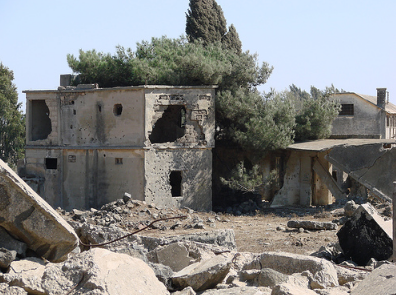Breaking
A new type of deal to reduce violence in Syria

The Russian plan to create safe zones in Syria, which came into effect Saturday, is the latest in a string of efforts to ease the country’s horrendous violence. After past failures, this deal provides for the first time a mechanism to observe the cease-fire: Russian, Iranian and Turkish troops are to monitor compliance on the ground. (Photo: watchsmart/Facebook)
BEIRUT — The Russian plan to create safe zones in Syria, which came into effect Saturday, is the latest in a string of efforts to ease the country’s horrendous violence. After past failures, this deal provides for the first time a mechanism to observe the cease-fire: Russian, Iranian and Turkish troops are to monitor compliance on the ground.
But there are also worrisome flaws that could doom the deal to the same fate as its predecessors.
Key details remain vague — like what are the borders of the safe zones where fighting will stop?
No Syrian party has signed onto the deal. The presumption is that Russia and Iran will ensure compliance of their ally, the government of President Bashar Assad, and opposition-backer Turkey will bring rebel factions on board. But the opposition reacted harshly, blasting the deal as lacking legitimacy.
The United Nations expressed support. The United States, which was not part of the negotiations in Kazakhstan that reached the proposal, said there is reason to “be cautious” about the chances for success, but urged the Syrian opposition to engage with it seriously.
Here is what is known:
WHAT ARE THE CEASE-FIRE TERMS?
The deal calls on the warring parties to halt the use of all kinds of weapons in the designated “de-escalation zones,” including air force flights. Moscow says that includes flight and strikes by Syrian war planes and air raids by the U.S.-led coalition.
What the deal does not cover are areas controlled by Islamic State group militants and U.S.-backed Kurdish groups.
That leaves the U.S. and its allies free to continue the campaign to retake IS-held territory. It doesn’t prevent frictions between Turkish troops and their Syrian allies from clashing or going after the U.S.-backed Syrian Kurds.
The halt aims to allow humanitarian aid to access hard-to-reach and besieged areas in Syria, were at least 4.5 million people in need reside. The deal also calls for refugees to be allowed to return to the safe zones and services and infrastructure to be restored.
WHERE ARE THESE ZONES?
Russia says maps delineating the zones should be ready by June 4. So it is not clear how the halt of airstrikes and other violence will be monitored for the month before then.
But the zones, as described on paper so far, are to cover the main battlegrounds in the fighting between rebel forces and Assad’s military.
The largest covers northern Idlib province, the opposition-held enclave near the Turkish border, and parts of neighbouring Aleppo, Hama and Latakia provinces where fighting has been fierce. Another is the northern part of Homs province. The third is around Eastern Ghouta, a rebel-held suburb of Damascus that the government has failed for years to take. The fourth covers a front-line area in the south near the border with Jordan.
Russia said it could be expanded to create more zones. The opposition says a cease-fire should include all of Syria.
HOW DO THE ARMED OBSERVERS WORK?
Previous cease-fires have quickly faltered because of the complex terrain and lack of implementation or monitoring mechanisms.
So under the proposal, Russian, Iranian and Turkish troops will monitor “security belts” on the edges of the “de-escalation zones.” Armed forces will man checkpoints and observation points to monitor violations and facilitate movement of civilians. The deal says other nations could join as needed.
The size of such a force is unclear, and its duties are murky, particularly without a U.N. mandate. The important question of who would monitor what areas is unanswered.
And most complicating of all, all three of those countries are already combatants mired in the war, far from neutral “peacekeepers.”
Russia and Iran’s military support has been crucial to the survival of Assad’s government and the victories of his military. Russian warplanes helped bombard rebel areas like Aleppo into submission. Iran’s Revolutionary Guard troops have been fighting on the front lines alongside Assad’s troops, as well as fighters from Lebanon’s Hezbollah and Shiite militias from Iraq.
Still, in a call between President Donald Trump and Russian President Vladimir Putin earlier this week, the White House said the two had a positive conversation about ways to go about resolving the Syria crisis that included a “discussion of safe, or de-escalation, zones to achieve lasting peace for humanitarian and many other reasons.”
Turkey is a backer of the opposition, though its forces have not been fighting Assad. Instead, Turkish troops and allied Syrian factions have been fighting IS militants and a Syrian Kurdish group in the north.
The Iranian role as “observers,” formalizing the Iranian troop presence, seems particularly combustible. Rebel factions often express particular hatred for the Iranians and could target their forces. The opposition strongly rejects the idea that Iran can play a role in a cease-fire, accusing the Shiite-majority country of fueling the sectarian nature of the conflict and orchestrating population swaps that amount to demographic change.
Aron Lund, a Syria expert, said the deal may dampen violence and improve the humanitarian situation in some regions. But the delay in working out key details like the map could also undermine it.
“If or when it starts to crumble, it could also lead to destabilizing recriminations among the three signatories and their allies,” Lund wrote Friday. “While the deal is unlikely to end the Syrian conflict, it may help shape its future – for better and for worse.”





















